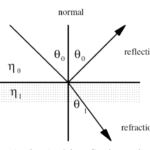What Is Reflection?
Reflection occurs when light hits a surface and bounces back. Reflected light makes images appear in mirrors and on other smooth, shiny surfaces
Laws of Reflection:
The Angle of Incidence Equals the Angle of Reflection:
When a light ray hits a surface, the angle at which it hits (called the angle of incidence) is exactly equal to the angle at which it bounces off (called the angle of reflection)
The Incident Ray, Reflected Ray, and Normal Line Lie in the Same Plane:
The incoming light, the reflected light, and the line straight up from where the light hits all lie on the same flat surface.
What Is Refraction?
Refraction occurs when light passes from one material to another and bends. This bending happens because light travels at different speeds in different materials. For example, light moving from air into water slows down and changes direction.
Laws of Refraction:
First Law of Refraction:
The incident ray, the refracted ray, and the normal to the interface all lie in the same plane.
Second Law of Refraction:
If light slows down when it enters a new material (like going from air to water), it bends toward the normal line. If it speeds up (like going from water to air), it bends away from the normal line.
Practical Applications
- Mirrors use reflection to help us see our image. They are used in cars and even in telescopes to view distant objects.
- Periscopes use mirrors to allow people to see over or around obstacles. They are commonly used in submarines.
- Eyeglasses use lenses to refract light and correct vision. Lenses bend light to help people see clearly at different distances.
- Cameras use lenses to refract light and capture clear images of scenes and objects.
- Fiber Optic Cables use both reflection and refraction to transmit data as light signals.
Fun Facts
Here are some interesting facts about reflection & refraction:
- Many animals, like cats, have a reflective layer called the tapetum lucidum that helps them see better in the dark by reflecting light back through their eyes.
- Retroreflection is when surfaces like road signs and bike reflectors reflect light back to their source, helping drivers see in the dark.
- Rainbows are a beautiful example of both reflection and refraction.
- Mirrors in fun houses distort reflections by curving inward or outward.
Review
Let’s quickly recap what we learned about reflection & refraction:
- What happens to light when it bounces off a surface? Reflection
- What is it called when light bends as it passes from one material to another? Refraction
- What natural phenomenon involves both reflection and refraction? Rainbow
- What happens to light when it slows down and enters a new material, like moving from air into water? Bends Towards The Normal


Recent Comments